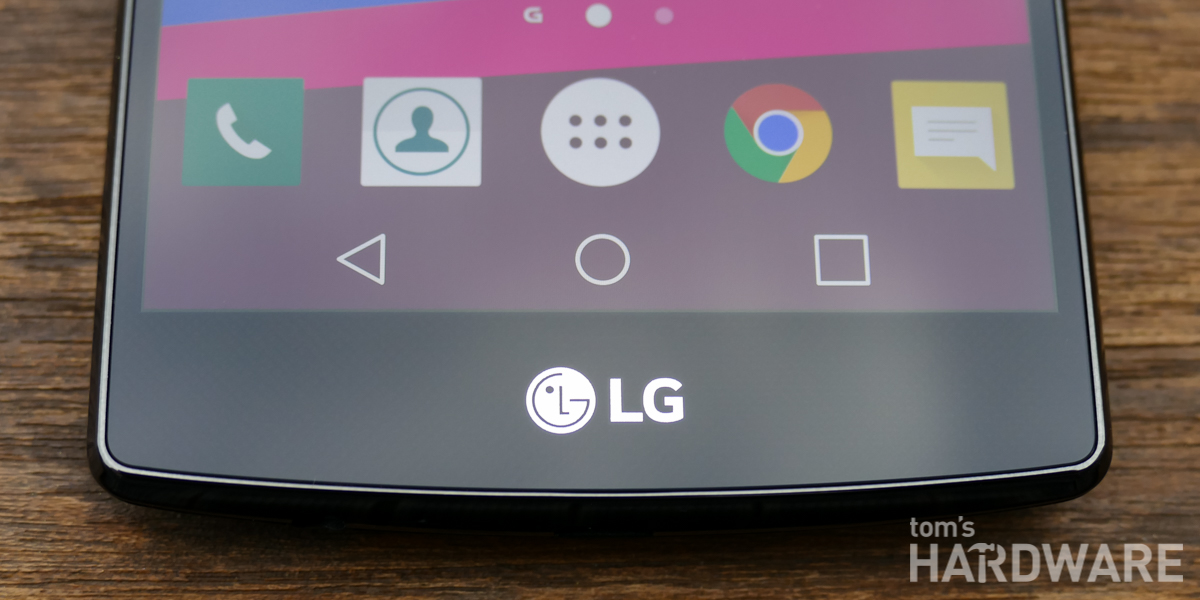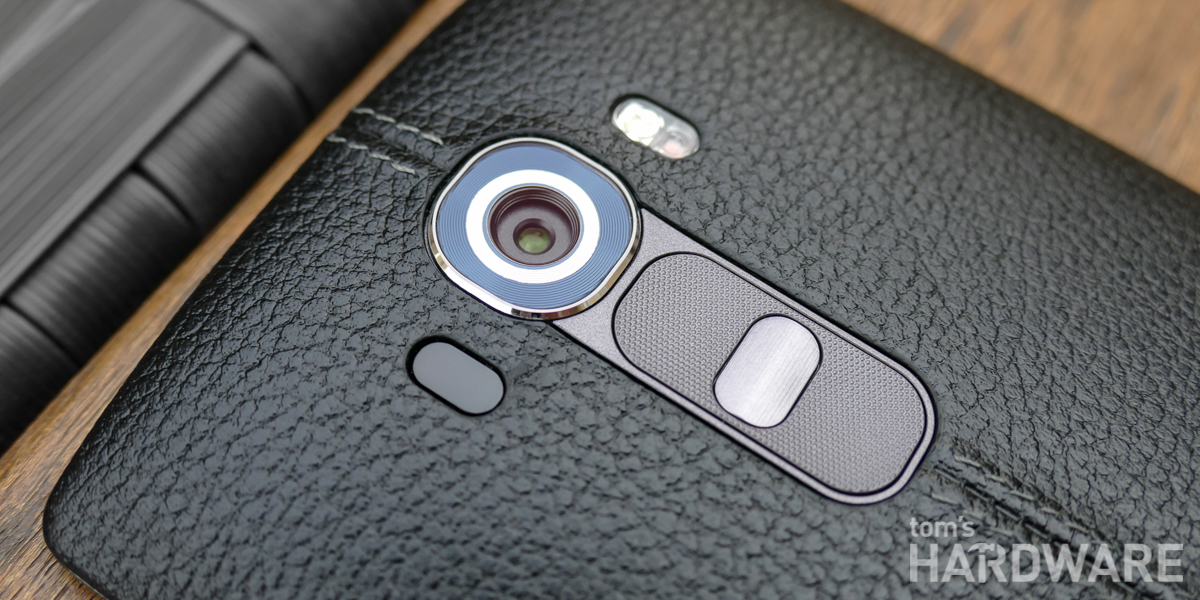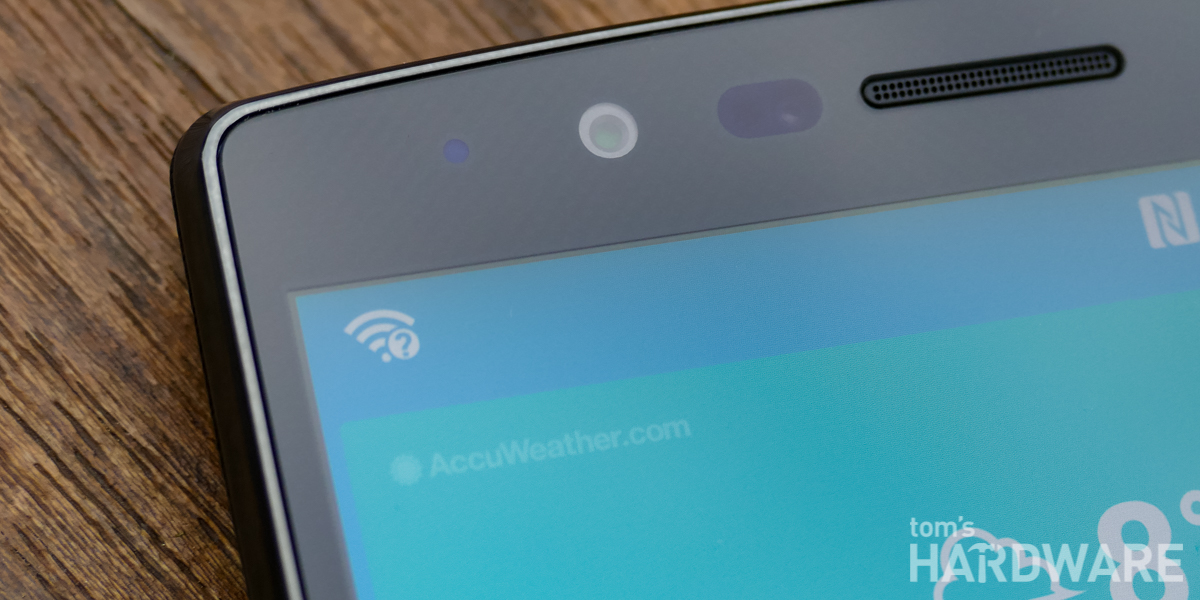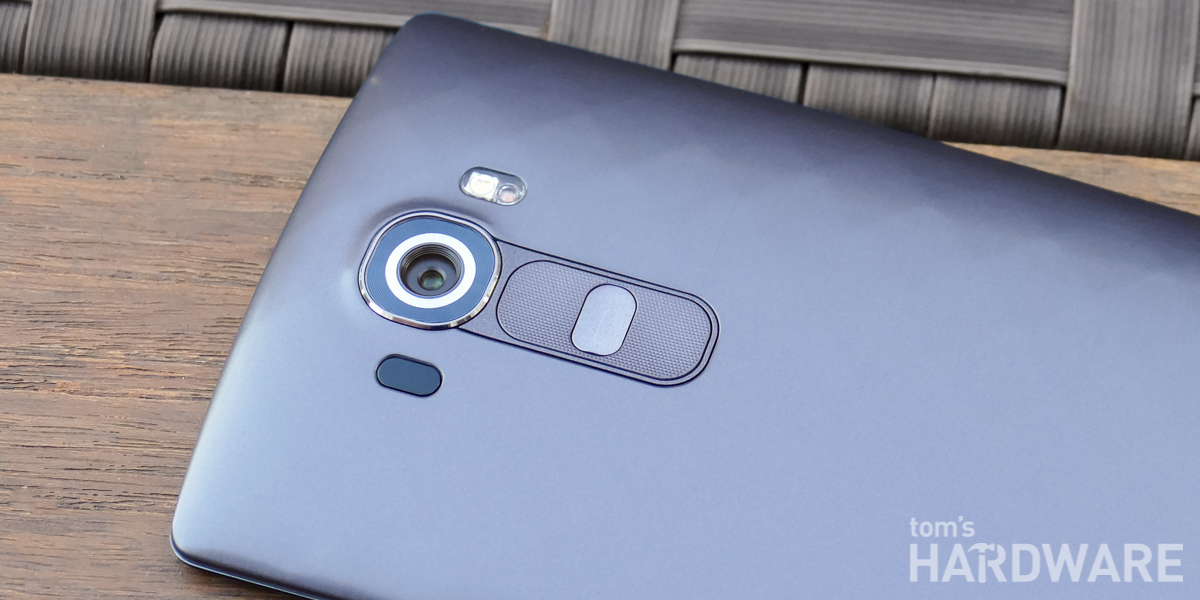LG G4 Review
The LG G4 retains a familiar look and still packs a removable battery and microSD slot, but it receives several internal upgrades, including a Snapdragon 808 SoC, an all-new camera, and a QHD IPS Quantum Display.
Why you can trust Tom's Hardware
Conclusion
At first glance, the G4 seems relatively unchanged from last year’s G3; it still comes with a removable battery and microSD card slot—a rare combo for flagship phones these days—and it continues the G3’s design language: minimal bezels with onscreen controls and rear-mounted buttons.
A closer inspection, however, reveals several subtle differences in the G4’s outward appearance. The upper and lower bezels are a little taller, which actually provides more room to rest your thumb when holding it with one hand, and they’ve also taken on a faux carbon fiber look. The G4 is more comfortable to hold against your face when actually using it as a phone thanks to the slightly curved 5.5-inch IPS screen that’s similar to LG’s G Flex 2, but with a less pronounced arc and none of its flexibility. Around back, LG’s signature power and volume buttons get reshaped, making them easier to locate and use.
For this generation at least, LG largely resists the current smartphone trend towards using more expensive materials such as aluminum and glass; the G4, like the G3, is still a plastic phone with a metal midframe for added stiffness. LG’s sole concession to those craving a more luxurious appearance are a series of optional leather-clad backs that do look and feel very nice.
Moving on from pretense to performance, LG equips the G4 with a Snapdragon 808 SoC, a step down from the Snapdragon 810. Our testing, however, vindicates LG’s decision. By dropping two of the power-hungry A57 CPU cores, the 808 is better able to stay within its thermal envelope, allowing it to use the remaining A57 cores more frequently and at higher frequencies than the Snapdragon 810. This gives the LG G4 a performance advantage over the HTC One M9 in a variety of CPU and system level tests.
That’s the good news. The bad news is the G4 cannot match the performance of other flagship phones from Samsung or Apple. Even the far less expensive Asus ZenFone 2 performs better than the G4 in everyday use. The G4’s faster CPU and speedy internal storage combine to boost performance by roughly 30% over the G3, which is enough to be noticeable at least.
While the G4 is not the fastest phone available, it’s still fast enough. Apps launch very quickly, almost as fast as on the Galaxy S6, and the UI is responsive with only an occasional hiccup. We found web pages scroll smoothly, and the G4 handles multitasking well, even when using the multi-window features.
The Adreno 418 GPU in the G4 improves gaming performance by 30% on average over the G3, and it’s not too much slower than the Adreno 420 in Snapdragon 805. Our tests show that using the same LPDDR3 memory as the G3 limits the peak performance of the G4’s GPU, which still struggles occasionally when rendering at the display’s native QHD resolution. Fortunately, these issues did not detract from our gaming experience. Most games render at lower resolutions and then scale up to the native panel resolution anyway, and the G4 did not experience any significant thermal throttling, even after pushing it hard for an hour.
Get Tom's Hardware's best news and in-depth reviews, straight to your inbox.
The uptick in performance causes a slight regression in battery life compared to the G3, especially in compute-heavy tasks, like video editing, that fire up the A57 CPU cores. Despite its smaller battery, the Galaxy S6 lasts longer on a charge than the G4, while still providing better performance. That being said, the difference in battery life is not much, and the G4’s battery life is generally comparable to other flagship phones.
The G4’s cameras are definitely an improvement over those in the G3, and while the rear camera is capable of producing some nice images in Auto mode, it fails to attain the same performance and quality levels as the Galaxy S6 (with Sony IMX240 Exmor RS sensor) and iPhone 6s Plus. The G4 shows a tendency to underexpose images, and despite the new color spectrum sensor, the G4 struggles with white balance, showing a preference for warmer colors. Both of these issues, while fairly consistent, are relatively mild, however, and can be overcome if you take advantage of the G4’s manual camera mode, currently the best available in a smartphone.
The rear camera’s f/1.8 lens lets in more light than any other smartphone lens, decreasing noise in low-light situations. Image noise in brighter scenes is similar between the G4 and Galaxy S6, although the G4’s post-processing noise reduction reduces sharpness slightly. In low-light images, the G4’s noise reduction excels, nicely smoothing noise grain without destroying texture and detail, making this the best implementation of noise reduction we’ve seen yet.
Similar to the G3, we found the G4’s autofocus performance to be inconsistent. The laser AF system is definitely competitive with the phase detect AF used by the Galaxy S6 and iPhone 6s Plus when it works. There are many scenarios where the laser AF fails, however, forcing the G4’s camera to fall back to the much slower contrast detect AF method. We also encountered several instances when shooting outdoors in shadow or overcast conditions where the G4 was unable to focus at all, leaving us with blurry images.
The G4’s new 5.5-inch IPS Quantum display has an impressive sounding name but disappointing performance. The QHD screen has an excellent black level and properly set gamma curve. Unfortunately, those are the only bright points—literally. Peak brightness falls just below 400 nits, about the same as the G3, but the usable peak brightness is only 321 nits. Once again, LG is playing games with the backlight, employing an automatic dimming feature that cannot be disabled or circumvented with third-party apps. After setting the brightness manually, the display will slowly dim over a period of about forty seconds. This appears to be a sneaky way of reducing power consumption at the expense of outdoor visibility. The G4’s brightness deficit is made even worse by a rather significant contrast shift at shallow viewing angles beyond about 45-degrees, which is surprising for an IPS panel.
LG’s claim about the display’s “56% improved color accuracy” is misleading. With no support for color management, the G4’s wide-gamut panel produces overly saturated colors that are actually less accurate than the colors displayed by the G3. The color temperature of the G4’s screen is also far too cool, which gives the screen a noticeable blue tint.
Another screen related issue some users reported was poor touch response. We did a significant amount of typing and game playing on our two G4 test units and did not experience any lag when registering touch inputs. On a few occasions, though, the screen would stop responding to all touch input, even though the system continued working and was not hung. The only way to get the touch input working again was to use the power button to lock (not power off) and then unlock the screen.
On the software side, the G4’s Lollipop-based OS is the best it has ever done, building on the features and refinements it started with the G3 when it rebooted its UI. However, despite all the improvements, LG is still a step behind Samsung’s TouchWiz, which performs well and offers a slightly better feature set, particularly its multi-window features. LG’s software, in comparison, is rife with UX inconsistencies and still lags intermittently; however, its smaller memory footprint gives it the edge in multitasking performance over TouchWiz.
The LG G4 is a very good smartphone, it’s just not the best. Both Apple’s and Samsung’s flagship phones offer better performance and battery life; they also have better screens and cameras. The G4 also lacks a fingerprint scanner, a great convenience feature that will become even more popular now with Android Marshmallow’s native API support. The G4 does have an ace up its sleeve, though: It’s one of the last remaining high-end phones that still comes with a removable battery and microSD support. If you need one or both of these features, the minor deficits in performance and photo quality are easily overlooked.
Alex Davies is a Contributing Writer for Tom's Hardware, covering Smartphones and Tablets. Follow him on Twitter.
Matt Humrick is a Staff Editor at Tom's Hardware, covering Smartphones and Tablets. Follow him on Twitter.
Follow us on Facebook, Google+, RSS, Twitter and YouTube.
-
cknobman Wife absolutely loves this phone and glad she picked this over the Samsung S6.Reply
While it does not have quite the specs the Galaxy S6 does the microSD slot and the removable battery make it the easy choice.
LG gave her a free premium leather cover and a extra battery with charging cradle.
Sealed batteries are terrible because when they go bad you either ditch the phone or pay big money to have it replaced.
I learned the hard way with my last phone that had a sealed battery, it will never happen again. -
geosol62 DONT YOU THINK THIS REVIEW IS A DAY LATE???? WTF!!!Reply
GET WITH THE Z170 ROUND UP ALREADY! -
jimmysmitty Reply16981641 said:Wife absolutely loves this phone and glad she picked this over the Samsung S6.
While it does not have quite the specs the Galaxy S6 does the microSD slot and the removable battery make it the easy choice.
LG gave her a free premium leather cover and a extra battery with charging cradle.
Sealed batteries are terrible because when they go bad you either ditch the phone or pay big money to have it replaced.
I learned the hard way with my last phone that had a sealed battery, it will never happen again.
I agree that a SD card slot would be nice but the battery is something I am not as convinced because most people move on from a smart phone in two years (now sooner with the new way they do their plans) and I have had a lot of phones and never had a battery die in that two year period. Only one of them started having issues with longevity of use and that was the Droid Bionic I had that was known for having horrible battery life.
The microSD is very nice though for music and pictures, especially if you use FLAC quality audio or take a ton of pictures.
I hops Samsung at least puts that back into the S7 but then again the Lumia 950XL looks very tempting especially with the USB Type-C and docking station. -
Rob_9_ The G5 could well be launched in 7-8 weeks. Tom must've been writing this this review for a good while ;-) I have a G4 - it's fast, reliable, skinny, has a beautiful display and you can swap the battery out when it gets low.Reply
LG work closely with Google and Quallcomm to get fast(ish) updates and searing performance.
The headphone jack is on the bottom so it doesn't dangle weirdly and obtrusively from the top of your device like most other handsets. Plus, you can edit the nav keys any way you want which is a welcome relief from the awkward placement of the stock buttons.
I've owned loads of phones. Ignore these benchmark and gamut 'ratings'. This phone really is awesome. And it's now very cheap. -
cknobman ReplyI hops Samsung at least puts that back into the S7 but then again the Lumia 950XL looks very tempting especially with the USB Type-C and docking station.
I have a Lumia 950xl on pre-order, ships Nov 25th.
Looking forward to it. -
SamSerious Apart from this review being more than late, i stopped reading after the first ten sentences. It is nonsense that early LG phones lacked quality and were copies of what Samsung offered at the same time. The firmware often spoiled the otherwise good phone, ok, but e.g. the build quality was always very high, these things were built like bricks. Even my Optimus P880 ist way more solid than any Samsung Andorid phone i know.Reply -
innocent bystander Got a G3 and nothing I see here makes me want to upgrade.Reply
Then again, I'm the type of smartphone user for whom a full charge will last 3 days... -
ptrick2000 It was impossible for me to delve into the review itself after reading the first paragraph. The Monkees later output produced generally great records? This analogy is an insult to LG.Reply -
SirGCal The V10 is out for everyone accept Sprint and the G4 Pro (GIMME GIMME GIMME) is rumored to be right around the corner. So this does seem a bit late.Reply





